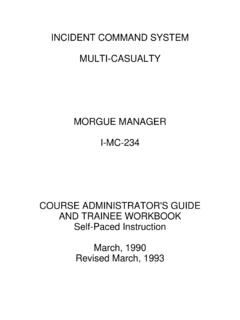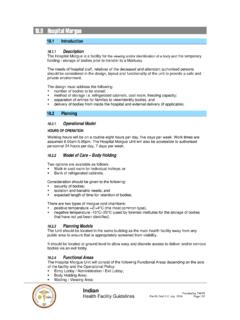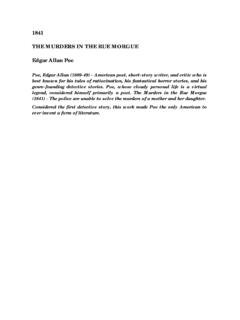Transcription of Disaster Mortuary Operational Response Team (DMORT)
1 Disaster Mortuary Operational Response team ( dmort ) Standard Operating Procedures 2008 Table of Contents dmort STANDARD OPERATING PROCEDURES FOR MASS FATALITY INCIDENTS 5 Purpose 5 Scope 5 Intended Audience 5 Executive Summary 5 FOR MEDICAL EXAMINERS AND CORONERS: SUMMARY OF PROCEDURES 7 dmort STANDARD OPERATING PROCEDURES 13 INTRODUCTION AND OVERVIEW 13 Victim Identification in Mass Disasters 13 National Response Plan 14 Jurisdictional Responsibility and Federal Support 15 Using dmort and Local Response Teams
2 15 Initial Meetings with Local and Federal Response Agencies 15 dmort Role in Family Briefings 16 Fatality Management Considerations 16 Family/Next of Kin Considerations for Decedent Information 17 Death Notification/Notification of Identification 17 Identification of Decedents vs. Identification of Remains 18 Use of DNA 18 Records Management and Long-Term Support 19 NDMS/ dmort Information 19 INCIDENT SITE OPERATIONS 22 Human Remains Retrieval
3 22 Field Safety Briefing 22 Decontamination of Remains 22 Temporary/Holding Morgue 23 Transportation of Remains to Incident Morgue 23 INCIDENT MORGUE OPERATIONS 25 Site Selection and Requirements 25 Establishing the DPMU 27 Morgue Security 30 Personal Protective Equipment 30 Photography Policy 31 DOCUMENTATION AND ANALYSIS OF REMAINS 32 Morgue
4 Flow Chart 32 Radiography of Remains Container 34 Triage of Remains and Evidence 34 Admitting and Numbering of Remains 36 Escorts 37 Photography of Remains 37 Radiology 38 Odontology 39 Pathology 41 Anthropology 41 DNA Specimen Collection
5 42 Data Management 46 FAMILY ASSISTANCE CENTER 51 IDENTIFICATION PROCEDURES 54 Identification Documentation team 54 DEATH CERTIFICATION AND DEATH NOTIFICATION 58 FINAL PREPARATION AND DISPOSITION OF REMAINS 59 Post-Identification Holding in the Incident Morgue 59 Reassociation of Remains 59 Identification Documentation 60 Embalming Section 60 Casketing
6 61 Cremation 61 Funeral Home Contact Information 62 Transportation of Decedents from Morgue 62 INCIDENT MORGUE DEMOBILIZATION 65 dmort team Demobilization 66 AFTER ACTION REPORT 67 APPENDIX A 68 Acronym Reference List 68 4 dmort Standard Operating Procedures for Mass Fatality Incidents Purpose The dmort SOPs were developed in order to provide a comprehensive reference that describes the standard approach to mass fatality management by members of the National Disaster Medical System s (NDMS)
7 Disaster Mortuary Operational Response Teams (DMORTs). The SOPs will outline authority, scope, standards and processes to facilitate the execution of approved policy level recommendations by NDMS Headquarters, by the dmort teams, and by individual members operating in the field on any non-transportation related mass fatality incident involving Federal government assets and resources. These SOPs will provide a standard approach regardless of causative force, geographic location or specific team (s) deployed. Additionally, these serve as a significant reference in the development of field training programs and exercises for dmort teams and personnel.
8 Scope The dmort SOPs are the approved procedures that will be utilized by all NDMS and dmort teams members at the Disaster site(s), incident examination center(s), incident morgue(s), fatality collection center(s), fatality transfer center(s), and all other facilities established on a specific incident or mission for the purpose of mass fatality management, support, or coordination. Intended Audience The intended audience comprises NDMS personnel, dmort personnel, Medical Examiner/Coroner (ME/C) personnel, and local officials involved in Disaster planning and emergency/ Disaster Response . Executive Summary These SOPs delineate the general procedures used for dmort operations when activated under NDMS.
9 They are designed to provide public safety, public health, medical examiners, coroners, and other emergency management, medicolegal and emergency Response stakeholders with accurate information in reference to how the NDMS dmort system operates in the Response to mass fatality incidents involving a number of fatalities exceeding the resources available to a local jurisdiction. These SOPs were created to give structure to the well-established team of victim identification experts known as the Disaster Mortuary Operational Response team or dmort . The legal responsibility of the ME/C to identify Disaster victims is well established in the United States, and it is maintained when a mass fatality incident occurs.
10 The ME/C systems in the U. S. range from the professionally trained forensic pathologist to the rural county elected coroner with little medical background. Given this disparity, when a Disaster occurs, the ability of the jurisdiction to respond effectively is a sometimes a concern. The dmort system allows for Disaster victim identificat









